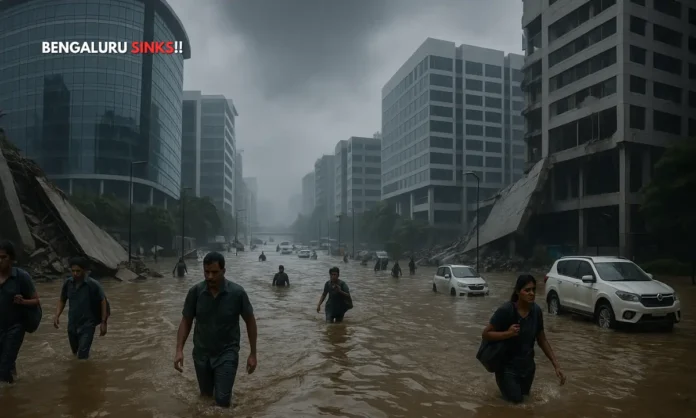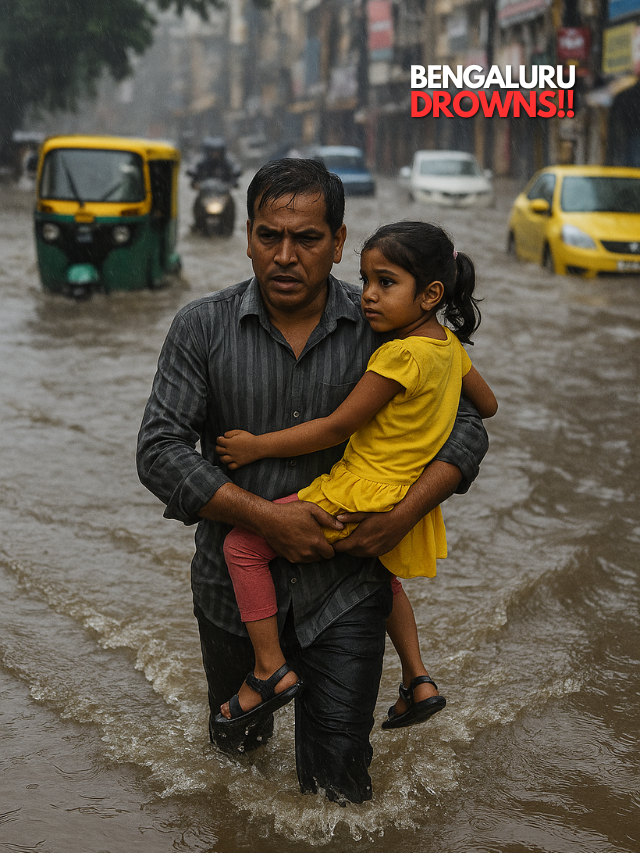SUMMARY
- Bengaluru witnessed its worst pre-monsoon floods in over a decade, with more than 100 mm rainfall reported in a single day.
- Three lives were lost and major IT corridors submerged, reigniting debates on unchecked urban development and civic negligence.
- As state authorities deflect blame, the tech capital’s infrastructure crisis is now a national concern—amid looming climate volatility.
When the Cloud Burst Over Code: A City Brought to Its Knees
What happens when India’s Silicon Valley becomes a waterlogged maze of stranded commuters, crumbling tech parks, and knee-deep uncertainty? The answer surfaced brutally this May, as the “Bengaluru floods May 2025″ etched another chapter in the city’s chronicle of civic collapse. Triggered by intense pre-monsoon showers linked to cyclonic activity over the Andaman Sea, the deluge submerged large swathes of the city, including key economic zones.
With rainfall breaching 100 mm on Monday—the heaviest since 2011—several residential and commercial areas were inundated. The consequences were grim: three reported deaths, including a 12-year-old boy and a female employee crushed under a collapsed wall of an IT firm, i-Zed, in the tech corridor. The calamity prompted several global firms to switch to remote work as transport networks failed.
Though Deputy CM DK Shivakumar attempted to allay fears with assurances of ongoing action across 210 flood-prone zones, public frustration exploded online. Social media flooded with images of submerged homes and choked streets, revealing not just water levels, but a deeper crisis of accountability and planning.
Under Congress rule, Bengaluru has turned into a disaster zone — 130mm rain in just 12 hours has exposed the utter failure of city planning.
— Vishnu Vardhan Reddy (@SVishnuReddy) May 20, 2025
Streets submerged, over 500 homes affected, traffic in shambles, widespread power cuts, and 3 precious lives lost.
This is what years of… pic.twitter.com/a3JILDrk1k
Urban Ambition Meets Wetland Warnings: The Invisible Cost of Growth
- Newly developed tech zones bore the brunt of the floods, particularly those built over wetlands and lake beds.
- Infrastructure in emerging zones crumbled faster than in older neighborhoods.
- Experts blame a lack of coherent urban planning, weak zoning regulations, and unsustainable land use.
The 2025 floods have highlighted Bengaluru’s paradox: a global tech powerhouse built on fragile foundations. Experts have long warned against the city’s aggressive vertical growth that has engulfed its ecological buffers—wetlands, stormwater channels, and lakes. These natural flood moderators, now encased in concrete, have left rainwater with nowhere to go.
As Annu Itty, a long-time resident and policy expert, noted, “Ironically, it’s the newly developed areas—designed to host the city’s tech boom—that suffer the worst damage.” Her comments underline how Bengaluru’s urban blueprint, driven by short-term profit, is now confronting long-term collapse.
AIT president Ananda Rao echoed this sentiment, saying the recurring floods have created “inconvenience and discomfort” for over 450 member firms. “The state reaps taxes from our growth but fails to deliver on basic infrastructure,” he said. The real cost, it seems, is being paid in lost productivity, stranded innovation, and growing public resentment.
Political Blame Game Drowns Out Solutions
- The opposition BJP accused the ruling Congress government of negligence and demanded ₹10 billion in immediate relief.
- State officials countered by blaming years of mismanagement across previous regimes.
- Citizens remain stuck in the middle of rhetorical floods, with no sign of systemic change.
As videos of commuters wading through waist-deep water made headlines, political mudslinging followed swiftly. The BJP, now in opposition in Karnataka, accused the Congress-led administration of wasting crores on “ineffective” infrastructure overhauls. They demanded an urgent ₹10 billion relief package.
The Congress, in response, reiterated that the city’s problems predate their current term. “These are legacy issues,” said Deputy CM Shivakumar. “Years of poor planning and unregulated expansion have brought us here.”
But for citizens, such admissions ring hollow. “Bengaluru contributes significantly in taxes, but we get no return on this investment,” said Rao of AIT. The truth is evident: regardless of who rules, the city floods—and the people pay.
Beyond Buckets and Blame: A Blueprint for Resilience
To address the “Bengaluru floods May 2025” with seriousness, Karnataka must rise above political scapegoating and embrace real urban resilience. This means rebuilding lost wetlands, investing in modern drainage systems, and ensuring that new construction meets sustainable planning codes.
More critically, it demands civic transparency and public participation—because when water rises, it spares no party line.
The tech capital’s future cannot be built on foundations that wash away every monsoon. Bengaluru may write code for the world, but unless it decodes its own urban vulnerabilities, the next deluge may not just drown roads—it could sink the dream itself.



